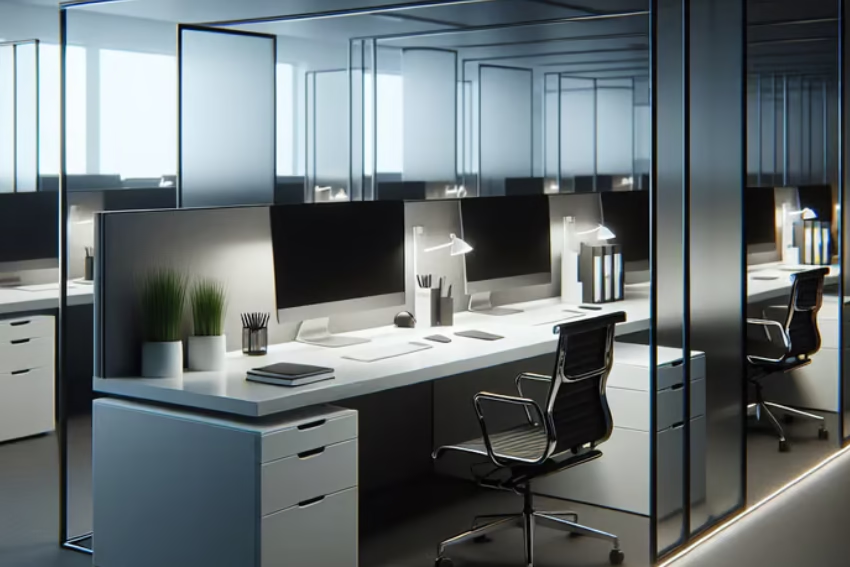Of all the disorders that seem inevitable in today’s workplace, noise pollution is considered to be the most disruptive to productivity, attention, and employee health. While the concept of an open-space work environment is really effective in integrating communication and group work in the office, it also brings unwanted noise that hinders work and causes distractions. This is where Office cubicles come into the picture as one of the best solutions to the issue of high noise levels.

Far from outdated devices that were previously used as a degrading combination of offices and corners, office cubicles have been reimagined as an attractive solution for the office that can bring together the benefits of collaboration with individual work opportunities.
This shows how sound control in the office through optimally designed cubicles proves to be an effective work solution in negating the negative effects of noise and providing privacy within the work environment. Only by appreciating this will one be able to make appropriate decisions to ensure that cubicles are incorporated into the office environment in a way that guarantees noise control as well as promoting the need for employees to spend personal time regardless of their work environment.
Let us all together explore the various aspects of the use of office cubicles to help improve the work environment of offices in the current world.
Understanding Noise in the Workplace
To better understand the function of office cubicles, it is necessary to consider some details of noise in the work environment and its effect on employees. It is common to encounter noise in the office environment, which is often perceived as any unwanted sound arising from conversations, phones and other office equipment, traffic, etc. The effect of noise on productivity is well understood; in fact, noise is known to provoke stress, distraction and poor decision-making and reduce overall job satisfaction.
According to the World Health Organization, the following health problems are attributed to exposure to high levels of noise: sleep disturbances, cardiovascular diseases and impaired cognition in children. Thus, noise control can be considered not only as an issue related to efficiency, but also to the protection of workers’ health.
The Role of Office Cubicles in Noise Reduction
1. Physical Barriers
This is the spatial division of offices provided by cubicles. Cubicles divide the office space into sections so that many forms of sound cannot easily travel from one area to another. Some traditional concepts of cubicles are very loud.
In fact, they cover the floor to the ceiling and thus mute the sound waves. Fabric-covered panels and acoustic foam are also used to enhance noise attenuation as they do not allow the sound waves to bounce back.
2. Sound Absorption and Diffusion
Office spaces in today’s world have become quite ergonomic and sound proof, even in the modern cubicles available for employees. They are usually designed with sound controls that prevent echoes and reverberations inside, a problem mostly felt in open space working environments.
Absorptive and diffusing materials are used in panels and partitions to ensure that sound waves cannot enter inside. They are reflected and diffused to ensure that there is no noisy space. This diffusion is more essential in large rooms that lead to reverberations, turning a weak sound into a loud sensation.
3. Zoning and Layout Optimization
One of the benefits associated with the use of cubicles today is that it can be used to create compartmentalization in the workplace. Certainly, by arranging cubicles according to functional divisions within the organization, loud auditory communication can be efficiently controlled.
For example, it is possible to designate quiet areas or work-only stations near busy routes with the aim of helping employees prevent disruptions. Similarly, it may be possible to group together activities that demand a lot of interaction, for example employee canteens, with some separation to prevent interference with other functions of the office layout.
4. Privacy and Concentration
Thus, a person can be completely isolated from all other people and be alone with the essential task at hand, thus cubicles enable effective focus. The management of the organization can reduce the noise levels in the work environment by eliminating sources that may contribute to noise such as conversation noise. This is whereby employees may be distracted by the noise of their co-workers’ conversations.
Privacy means having a space that is closed off which can positively affect productivity and job satisfaction levels. It is most useful for tasks that require some degree of thinking and concentration to perform correctly.
5. Flexibility and Customization
Office cubicles are versatile when it comes to designs and solutions, making it easy for businesses to design their own acoustic solutions. Modular furniture such as partitions, movable dividers, and components are some of the adaptable features that can be used to organize an office.
This is quite helpful in settings where team structures and roles are constantly changing or evolving. Intelligent cubicles allow for the creation of acoustic environments that can be adjusted based on changes in the work process.
6. Integration with Technology
With current socio-technological advances in acoustic engineering, sound-masking systems can be installed in cubicle designs. These systems play white noise or other sounds that eliminate unwanted noise and thus provide an environment in which no disturbances can be detected.
If combined with the proper design of workstations such as cubicles, technological noise control is another effective strategy that can be used to complement noise reduction.
Dispelling Myth and Misconceptions
Office cubicles have several disadvantages. The biggest disadvantage is that they limit interaction between employees. To combat these issues, the architecture of modern cubicles includes elements that facilitate interaction but also eliminate noise.
For example, low partitions or glass partitions can be used that provide visibility with auditory privacy. Finally, local spaces and interaction areas should be placed in such a way that they can be easily accessed by different cubicles where multiple people work in teams.
Case Studies and Real-World Applications
Case Study 1: A Tech Startup’s Success with Cubicles
Many noise challenges emerged in an open playground after a rapidly growing tech startup widened the office. To address this, they put in place a modular cubicle system that would enhance the zoning of the area.
Areas with high traffic were the ones that got earmarked as quiet zones, the collaborative spaces therefore were grouped together. This has had quite a positive impact on concentration among employees and stress levels hence increased productivity and job satisfaction.
Case Study 2: Healthcare Provider Reduces Noise with Customized Cubicles
A healthcare provider noted that there was a high noise level in the administrative workplaces and its negative impacts on the employees. They have also provided specified cubicles and added some pieces of fabric, number pads and noise-reduction instruments.
The new design had separate offices with divisions for working in solitude and receptions inhabited by tables for project and brainstorming work. Follow-up surveys showed that there was a reduction in noise levels as perceived by the employees while their morale was boosted.
Best Practices for Implementing Office Cubicles
1. Assessing Needs and Layout
Before installing cubicles in your office space, it is important to determine how sound will be a problem or the space needed in the office. Determine which zones require noise attenuation most of all and take into consideration the office traffic patterns. The strategies that will be used in this assessment will enable the designing and placement of the cubicles in a perfect manner.
2. Choosing the Right Materials
Don’t select the most effective materials for sound absorption that are not appealing to look at. It is wise to use fabrics; acoustic foam; and modular panels that have elements that can optimize soundproofing. It is also important to keep into consideration the endurance of the materials especially in heavily featured zones.
3. Design for Flexibility
Choose acoustic panels which can be easily dismantled and rearranged, to create more options for reconfiguration of the cubicle systems. This enables an office to adapt to new conditions without much later bringing radical changes when new conditions suffice. They need to add mechanisms such as controlling partitions and dividing them with screens to design flex changing spaces.
4. Balancing Privacy and Connectivity
They should thus provide cordons while still serving the need of people to work as a group. For the areas where visual contact is significant, it is recommendable to have low divisions or the use of glass partitions and the collaborative zones should be adjacent to the clusters of the enclosed cubicles.
5. Incorporating Technology
It is recommended to further improve noise attenuation characteristics of the cubicles utilizing major sound-control options, such as sound-masking systems and other acoustic solutions. These technologies can produce a steady auditory scene in this way that the effect of interfering noises will not be disruptive.
6. Gathering Feedback
If cubicles are used to reduce noise in the workplace, one should get feedback from the employees to gain perception of how effective it is. It can then be used to make suitable changes subject to the circumstances in ensuring that the office environment provides the best experience to the workforce.
Conclusion
Since workplaces are filled with various noises, it is crucial to minimize them to avoid any negative effects as they may affect the productivity of the workers and the organization. Overall, the sound damp that is provided by office partitions when well designed and installed makes office cubicles an appropriate solution in solving noise issues.
This article explains how physical barriers, improved soundproofing, adjustment of the office space, and flexibility of employee relocation, der noise and chaos from a workplace and make it friendly for productivity. Thus, it is critical to acknowledge the issues having to do with isolation and communication that are somehow connected with modern forms of the cubicle.
Hence, it is established that the office cubicles should be planned, designed, constructed, and implemented in the most suitable and effective manner to withstand the above-discussed challenges. If implemented, such measures will help to take full advantage of the prospects that are provided by office cubicles for improving the level of quiet, productivity, and focus.






